 |
||
|
||
| ||
We continue to keep an eye on chips from NVIDIA of GeForce2 series. Not so long ago we considered the videocard based on GeForce2 Ultra. This card is of high-end class and costs $450. The price range of the described series based on GPU GeForce2 GTS constitutes $220-250 for 32 MBytes variant (and $310-340 for 64 MBytes). There is a quite big difference between mainstream and high-end cards. Probably, soon we could see a new card in the range of $340-450. Yet before the announce of GPU GeForce2 Ultra we knew about GeForce2 Pro chip, which will be this connecting link. GeForce2 Pro based videocards have a graphics processor with core working frequency at 200 MHz. This card has a faster DDR-memory, that works at 200 (400) MHz. The performance of it must be between GeForce2 GTS and GeForce2 Ultra. GeForce2 Pro is a chip which is installed in the videocards with only 64 MBytes local memory. Below you can see the whole series of the cards based on GPU GeForce2:
The mentioned list is added to GeForce 256 DDR 32 MBytes based cards, which are still selling actively at $160-180 ($120-140 to the end of the year). Now you have a full menu of 3D accelerators based on GPU from NVIDIA. In this article we'll consider the first card based on GeForce2 Pro which we could put our hand on, this is ASUS AGP-V7700 Pro. No one will dare doubt that ASUSTeK offer high quality products, a rich complete set, unigue engeneering developments allowing a user to adjust modern 3D accelerators as what they want. At the time of announce of first GeForce 2 GTS based cards many manufacturers offered 64 MBytes versions of their accelerators. Undoubtedly, the main deterrent was the price, and the manufacturers were afraid that those cards would hardly sell. In result, the cards with 64 MBytes local memory started their way quite gingerly. Indeed, in case of GeForce2 GTS the memory resulting frequency is the same for both card variants - 333 MHz (they differ only in memory size). And as you all know the main bottleneck is not the memory size, but a memory bus bandwidth. For GeForce2 GTS the bigger memory size can be required only by applications with huge textures or when working at high resolutions. As for the first case, there are practically no such game applications. And as for high resolutions no games can work at the acceptable reliability level. Nevertheless, GeForce2 GTS based vidoecards with 64 MBytes local memory were released, though they sold quite badly, since everybody was waiting for GeForce2 cards with a higher performance memory. And at last, we can witness their appearing. GeForce2 Pro based cards have got faster memory, what makes gamable all higher resolutions. And it means that 64 MBytes memory size can suit already to some games. It was a year ago, when one of Quake3 developers said that that game at 1600x1200x32 at many levels would use 54 MBytes of textures. Though at that time it was just one of the theoretically possible ways, and today many just play at this resolution with GeForce2 Ultra based card. Are GeForce2 Pro based cards be able to give such opportunity? Well, we'll check it. BoardASUS AGP-V7700 Pro features:
Also take look on this and this article for additional information about GeForce 2 series. Let's turn to the card: The card has AGP2x/4x interface, 64 MBytes 5 ns DDR SDRAM located in 8 chips on the right side of PCB: 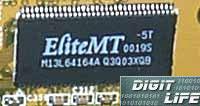 The memory chips are produced by EliteMT company and intended for 200 (400) MHz working frequency. Noteworthy is the fact that sometimes in specifications you can see not a working frequency, but a resulting one. That is if you read 400 MHz for DDR-memory, note that actually it works at 200 MHz. The card has an ordinary cooler without a tachometer. SmartDoctor system isn't here also. Judging by the provided data we can state, that ASUS used a reference design from NVIDIA. Under the cooler we have discovered GeForce2 Pro chip itself: 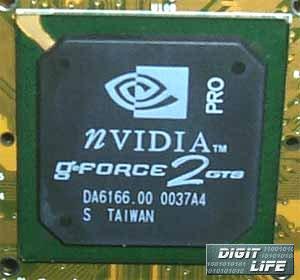 The board is a traditionally rich yellow. PCB has slots for a daughter card with TV-out. There is also a blank space for a connector for digital monitors. The card is enclosed in a usual box with a picture in avant-garde style: The complete set includes a user's manual and 4 CDs with the following software:
OverclockingWe managed to overclock the graphics processor up to 230 MHz, and the memory resulting frequency constituted 450 MHz. That's why one may to expect a performance gain when setting the board at higher frequency. Of cause, as you can see, that performance level of GeForce2 Ultra remains unachievable here. Installation and driversWell, as always we start with the testbed configuration:
Since the drivers which are supplied together with the card are outdated (the set is based on NVIDIA reference driver 5.33), we used drivers of Detonator3 series (6.35 beta), which showed considerable speed increase. For more information on the drivers, please, refer to the review on ASUS AGP-V7700. The test resultsLet's start with 2D-graphics. In the previous articles we stressed the perfect quality and high speed in 2D-graphics of GeForce2 GTS based cards. We'd like to add with pleasure that ASUS AGP-V7700Pro based card have practically the same high marks. The videocards of this class provide quality images for the majority. Besides, with the increased 2D quality of GeForce2 based cards as compared with NVIDIA GeForce 256 the owners of 21" monitors will be satisfied. Now we will consider the speed parameters of ASUS AGP-V7700Pro in 3D-graphics with 2 games:
These games are quite enough to show the performance when working via 2 main API. For you to compare we give the graphs of 2 more videocards: Inno3D Tornado GeForce2 GTS/64 and Creative 3D Blaster Annihilator2 Ultra based on GeForce2 Ultra. Besides, we will show the performance difference of ASUS AGP-V7700 Pro based card after overclocking. 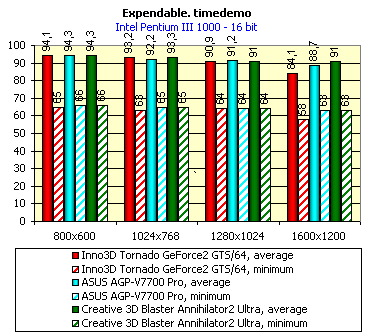 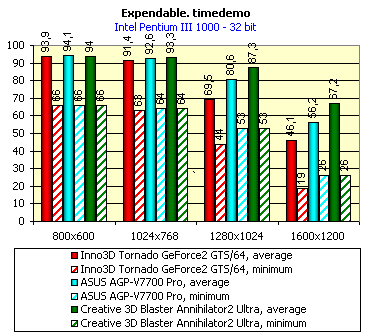 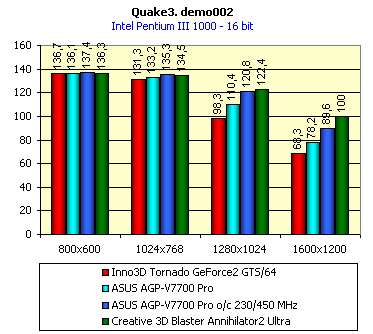  It's easy to notice that ASUS AGP-V7700 Pro outperformed GeForce2 GTS and GeForce2 Ultra based cards. You can see that in Expendable in 16-bit color the performance is limited by the CPU frequency almost at all resolutions (even 1 GHz of processor is insufficient for such accelerators!). In Quake3 in 16-bit color mode only at 1280x1024 and higher you can see the real performance, and at lower resolutions you will see that the system is set against the CPU performance. The same concerns 1024x768 @ 32 bpp. Without overclocking, the speed increase of GeForce2 Pro as comparing with GeForce2 GTS is achieved thanks to the faster memory. If you set the memory to supernumerary frequencies, the performance gain will be much more. Note that at these frequencies in overclocking mode the card from ASUSTeK worked with minimum additional cooling (in the system block we mounted only one additional fan). Other featuresAs for DVD-Video playback, we haven't any problems here. The supplied soft player ASUS DVD 2000 (based on PowerDVD 2.5 engine) was installed easily, image quality was excellent, CPU load was not more than 30%. ConclusionASUS AGP-V7700 Pro card is an extension of AGP-V7700 series and it shows good results in term of performance. Note that game possibilities are very promising for all resolutions, even at 1600x1200x32 you can play some single player games. Besides, it costs much less, than GeForce2 Ultra based card. So, if you're not playing at very high resolutions and you're looking for a high-speed 3D accelerator, you'd better pay attention to ASUS AGP-V7700 Pro. I should notice that its overclockability is quite promising. Though, to what extent the card could be overclocked depends on the definite card. ASUS AGP-V7700 Pro card is a bright representative of GPU family of the second generation from NVIDIA; it takes the second place (in terms of speed and price) after GeForce2 Ultra based cards. Highs:
Lows:
Write a comment below. No registration needed!
|
Platform · Video · Multimedia · Mobile · Other || About us & Privacy policy · Twitter · Facebook Copyright © Byrds Research & Publishing, Ltd., 1997–2011. All rights reserved. |